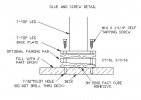The problem is the internet. When someone reads, over and over, on various forums... "I use 5200 and it's great", then one tends to believe what is written without doing their own research. BUT... those people that spout off about "5200 being so great"... what are THEIR credentials? Or are they just copying and pasting what they've read by someone else. YOU'RE asking the RIGHT question, John!
5200 actually has VERY few uses around a boat. It's an extremely strong ADHESIVE. The bond it creates is stronger than the bond between your fiberglass and gelcoat and can pull the gelcoat off the glass when removing an item. Most things we need to "seal" are held in place with mechanical fasteners. For that, you only need a SEALANT, not an adhesive. There is zero reasons to use an adhesive in most places. The deck to hull joint... THAT is a good place for 5200. But for other things - why would you want to make removal, down the road, SO much harder than it has to be... and, besides, it doesn't "seal" any better.
4200 is less of an adhesive but is still an adhesive, not a SEALANT. As noted above, both 5200 and 4200 are not UV stable, either.
For flat items (cleats, etc), the best thing to use is butyl rubber tape. Liquid (caulk) sealants are better for gaps. 3M4000 is good stuff. Personally, I've been using the Boat Life products for so long (including at the shop) that that's pretty much all I use (if I'm not using butyl rubber, that is). Life Seal for most things - Life Caulk if I want some strength, as well. A lot of people like using GE Silcone II from Home Depot for places where you would want to get into it again in a few years (gas tank hatch, for example)... plus their almond (I think?) color closely matches the newer Grady color. It's not as long lasting as the better stuff but it's less expensive and if you only need a few years out of it, then it's a good choice.


